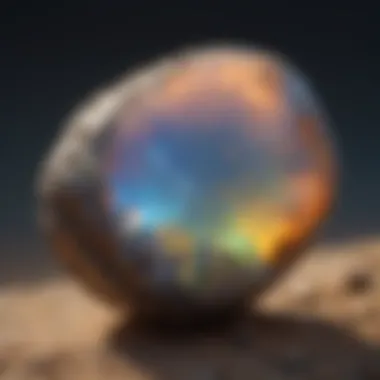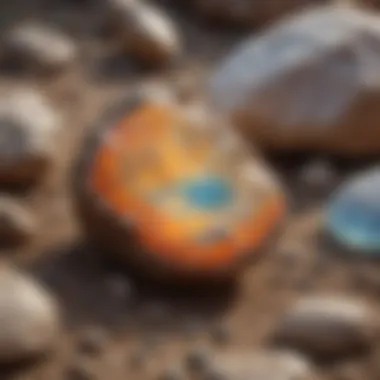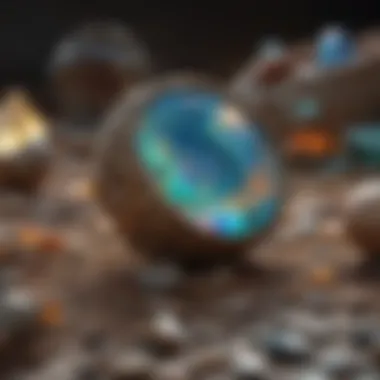Discover the Enchanting World of Large Rough Opal for Sale


Rock and Fossil Identification
Collecting Tips and Techniques
For enthusiastic collectors seeking large rough opal specimens, following best practices is crucial. Locating prime collecting sites involves researching geological maps to identify areas with opal-rich potential. Once on-site, safety measures should be prioritized when extracting opal specimens. Tools like rock hammers, chisels, and safety goggles are essential for safely retrieving opals from the surrounding rock matrix. Additionally, using a rock pick or geological pick can aid in precise extraction without damaging the opal.
Preservation and Display
Preserving large rough opal specimens requires special care to maintain their beauty and value. Techniques such as storing opals in a moist cloth or sealing them in plastic bags with water can prevent dehydration and cracking. Proper storage methods involve keeping opals away from heat and sunlight to avoid color fading. To exhibit opal treasures creatively, collectors can showcase them in shadow boxes with adjustable lighting to enhance their captivating iridescence.
Geological Insights
Introduction to Large Rough Opal
As we embark on a fascinating journey into the realm of large rough opal for sale, it is essential to grasp the significance of understanding these geological treasures. Large rough opals hold a unique allure for collectors and enthusiasts due to their raw and unpolished nature, showcasing the raw beauty that lies within. Exploring the world of large rough opal allows individuals to delve into the depths of Earth's formations and discover the mesmerizing complexities that nature has crafted over time.
Understanding Opals
Composition and Structure
Delving into the composition and structure of opals provides insight into the intricate makeup of these precious gems. Opals are composed of silica and water, with traces of other minerals giving rise to their stunning array of colors. The structure of opals consists of tiny spheres stacked in a grid-like pattern, refracting light to create their characteristic play-of-color. This unique composition and structure make opals a favorite choice for collectors seeking diversity and elegance in their gemstone collection.
Color Variations
Opals are renowned for their mesmerizing array of colors, from fiery reds to shimmering blues and luminous greens. These color variations are a result of the diffraction of light within the opal's structure, creating a kaleidoscope of hues that dance with each movement. The diverse color palette of opals adds to their allure, making them a popular choice for jewelry and collectors alike.
Opal Classification
Opals are classified based on their body tone, transparency, play-of-color, and patterns. This classification system helps categorize opals into different types, such as black opal, white opal, crystal opal, and fire opal. Understanding opal classification aids in identifying the quality and rarity of each specimen, guiding collectors in their pursuit of these stunning gems.
Formation of Rough Opals
Geological Processes
The formation of rough opals is a result of intricate geological processes that occur deep within the Earth's crust. Opals form through the interaction of silica-rich water with host rocks, creating pockets where silica deposits and solidifies over time. These geological processes, including weathering, deposition, and tectonic activity, contribute to the unique beauty and structure of rough opals.
Factors Influencing Formation
Various factors influence the formation of rough opals, including the presence of silica-rich solutions, geological disturbances, and the availability of host rocks. Climate conditions, volcanic activity, and geological stability also play a role in shaping the formation of opal deposits. Understanding these influencing factors provides valuable insights into the origins of rough opals and the conditions required for their creation.


Types of Opal Deposits
Opal deposits come in different forms, such as volcanic opal, sedimentary opal, and hydrothermal opal. Each type of opal deposit has distinct characteristics based on the geological processes that formed them. Volcanic opals, for example, are created through volcanic gas exchange and are often found in igneous rocks. Sedimentary opals, on the other hand, form in sedimentary environments through the deposition of silica-rich solutions. Exploring the various types of opal deposits offers a glimpse into the diversity of these stunning gems.
Significance of Large Rough Opal
Cultural and Historical Context
Large rough opals hold significant cultural and historical value, with past civilizations attributing mystical powers and healing properties to these gemstones. From ancient Roman beliefs in opal's protective qualities to Aboriginal cultures viewing opals as symbols of creation, the cultural significance of opals spans centuries. Exploring the cultural and historical context of large rough opals provides a deeper appreciation for their timeless allure.
Symbolism and Mythology
Opals have been steeped in symbolism and mythology throughout history, symbolizing love, hope, and purity in various cultures. In ancient times, opals were believed to possess magical properties and provide wearers with protection and intuition. The rich tapestry of symbolism surrounding opals adds an element of mystique to these geological wonders, making them highly sought after by collectors and connoisseurs.
Collectible Value
The collectible value of large rough opals lies in their rarity, quality, and provenance. Exceptional specimens with vibrant play-of-color and unique formations command high prices among collectors and investors. Understanding the factors that contribute to the collectible value of large rough opals enables individuals to make informed decisions when acquiring these prized gemstones. Whether for personal enjoyment or investment purposes, large rough opals offer a wealth of collectible value for enthusiasts in the field.
Exploring the Market for Large Rough Opal
In this section of the article, we delve into the crucial aspects of exploring the market for large rough opal, which plays a pivotal role in understanding the value and demand for these mesmerizing geological specimens. By focusing on the global demand and supply, assessing quality and value, and opportunities for acquisition, we provide valuable insights for rock and fossil collectors seeking to expand their collections with unique rough opal pieces.
Global Demand and Supply
Key Producing Regions
When it comes to large rough opal, key producing regions hold significant importance in the market landscape. Regions such as Australia, Ethiopia, and Mexico stand out for their rich opal deposits, contributing greatly to the overall availability and variety of opals in the market. These regions are known for their unique geological formations that give rise to opals with diverse colors and patterns, making them highly sought after by collectors and enthusiasts. The inherent geological characteristics of these regions, such as the presence of silica-rich sedimentary rocks and hydrothermal processes, make them ideal for opal formation.
Market Trends and Forecasts
Understanding market trends and forecasts is essential for navigating the world of large rough opal successfully. By keeping abreast of changing consumer preferences, economic factors, and technological advancements, collectors can make informed decisions regarding their acquisitions and investments. Market trends provide valuable insights into the evolving demands for specific opal varieties and shapes, guiding collectors on potential growth areas within the opal market. Additionally, forecasts offer a glimpse into the future trajectory of opal prices and availability, helping collectors strategize their purchasing decisions.
Challenges in Sourcing
While the market for large rough opal is vibrant and varied, it also poses certain challenges in sourcing high-quality specimens. Factors such as limited availability of premium rough opals, increased competition among buyers, and ethical considerations surrounding opal mining can present hurdles for collectors. Navigating these challenges requires meticulous research, networking with reliable suppliers, and a keen eye for assessing the authenticity and value of rough opal pieces. By addressing these sourcing challenges effectively, collectors can build valuable and sustainable opal collections.
Assessing Quality and Value
Criteria for Evaluation


When evaluating large rough opal pieces, certain criteria come into play to determine their quality and value. Factors such as color intensity, pattern clarity, play-of-color prominence, and size contribute to the overall appeal and pricing of rough opals. Collectors often look for specimens that exhibit vibrant color displays, unique patterns, and minimal imperfections to ensure they are acquiring high-quality opals for their collections. Understanding these evaluation criteria is crucial for making informed purchasing decisions and building a curated collection of exceptional rough opal specimens.
Factors Affecting Price
The pricing of large rough opals can vary significantly based on various factors that influence their market value. Considerations such as rarity, size, color play intensity, body tone, and origin play a significant role in determining the price of rough opal specimens. Collectors should be aware of these price-affecting factors to negotiate fair prices, identify investment-worthy pieces, and assess the long-term value appreciation potential of their opal acquisitions.
Authenticity and Certification
Ensuring the authenticity and certification of large rough opals is essential for verifying their origins and quality. Recognized gemological laboratories and experts provide certifications that detail the properties and characteristics of opal specimens, confirming their natural formation and lack of treatments. Certified opals not only instill buyer confidence but also serve as valuable documentation for future reselling or appraisal purposes. Collectors should prioritize acquiring certified rough opals to build a credible and reputable collection.
Opportunities for Acquisition
Auctions and Dealers
Participating in auctions and engaging with reputable dealers offer collectors opportunities to acquire rare and exceptional rough opal specimens. Auctions showcase a diverse range of opals from various regions, allowing collectors to bid on unique pieces that may not be readily available in the market. Conversely, established dealers provide a curated selection of high-quality opals with detailed provenance information, making them reliable sources for building a distinguished opal collection.
Online Platforms
The rise of online platforms has revolutionized the opal acquisition process, providing collectors with access to a global marketplace of rough opal specimens. Online platforms offer a convenient way to explore a vast selection of opals, compare prices, and connect with sellers worldwide. Collectors can leverage online platforms to discover rare opal varieties, interact with fellow enthusiasts, and stay updated on the latest trends and auctions within the opal community.
Customized Procurement
For collectors seeking personalized and tailored opal acquisitions, customized procurement services offer a bespoke buying experience. These services cater to individual preferences, budget constraints, and specific opal requirements, ensuring collectors find opals that align with their unique tastes and collection goals. Customized procurement enables collectors to commission custom-cut opals, source opals from select regions, or acquire opals with distinct characteristics, enhancing the exclusivity and personalization of their collections.
Preservation and Display of Large Rough Opal
The topic of 'Preservation and Display of Large Rough Opal' holds significant importance in this article as it sheds light on crucial elements vital for maintaining and showcasing these precious geological treasures. For collectors and enthusiasts invested in large rough opal, understanding how to preserve and display these specimens is essential for their long-term enjoyment and preservation of value. Detailed considerations must be made regarding storage, handling, and display techniques to ensure the opals remain in optimal condition.
Storage and Handling
Optimal Conditions
When discussing optimal conditions for storing and handling large rough opal, it is imperative to highlight the importance of maintaining stable temperatures and humidity levels. Opals are sensitive gemstones that can be adversely affected by fluctuations in environmental factors. By storing opals in environments with controlled temperature and humidity, collectors can minimize the risk of damage and preserve the opals' aesthetic and structural integrity. Optimal conditions also include protection from direct sunlight, as extended exposure can cause colors to fade and diminish the opal's vibrancy over time.
Protective Measures
Protective measures play a crucial role in safeguarding large rough opal from physical harm and external influences. Utilizing secure containers or display cases with cushioning materials helps prevent scratches, chips, or other forms of damage during handling or storage. Implementing protective measures such as soft padding or cloth can also mitigate the risk of abrasions and abrasions that may occur from contact with harder surfaces. By prioritizing protective measures, collectors can ensure the longevity and pristine appearance of their opal specimens.
Preventing Damage


Preventing damage is a continuous effort that involves proactive care and cautious handling of large rough opal. It is essential to avoid exposing opals to harsh chemicals or cleaning agents that can erode their surface or alter their appearance. Furthermore, regular inspection for potential vulnerabilities or stress points in the opal can help prevent any existing damage from worsening. By being mindful of potential risks and addressing them promptly, collectors can minimize the chances of damage and maintain the opals' natural beauty and appeal over time.
Conclusion and Future Prospects
The section of Conclusion and Future Prospects in this article provides a significant insight into the world of large rough opal for sale. It encapsulates the essence of opal appreciation, highlighting not just its geological significance but also its cultural and aesthetic value. Understanding the future prospects in this domain is crucial for both collectors and enthusiasts alike to stay abreast of emerging trends and innovations. By synthesizing the information presented throughout, readers can grasp the evolving landscape of opal sales and acquisitions. This section serves as a beacon for individuals looking to delve deeper into the world of large rough opal, offering a roadmap for continued exploration and appreciation.
Appreciating the Beauty of Large Rough Opal
Aesthetic Appeal:
The aesthetic appeal of large rough opal is unparalleled in the realm of geological wonders. Its iridescence and color play create a mesmerizing visual experience that captivates collectors and admirers alike. The unique sheen and patterns formed by light interacting with opal's structure make it a sought-after choice for connoisseurs seeking exemplary beauty in natural formations. Despite its fragile nature, the aesthetic allure of large rough opal remains a top choice for those looking to add a touch of elegance to their collections.
Emotional Connection:
The emotional connection forged with large rough opal transcends mere admiration; it delves into a deeper connection with nature's artistic prowess. The opal's ability to evoke a sense of wonder and tranquility in observers fosters a profound emotional bond that goes beyond mere material possession. Its rarity and mystique contribute to an emotional resonance that resonates with individuals passionate about collecting and appreciating unique geological specimens.
Inspiration for Collectors:
Large rough opal serves as a wellspring of inspiration for collectors, igniting a fascination with the natural world's intricate beauty. Its unpredictable formations and vast color variations offer a sense of endless possibility and discovery, fueling the passion of collectors to uncover the next exquisite specimen. Being a part of an exclusive community that treasures opals for their inherent allure can inspire individuals to embark on their own quest for unique and enchanting geological marvels.
Emerging Trends and Innovations
Sustainability Practices:
Sustainability practices in the opal industry play a pivotal role in ensuring the preservation of natural resources and ecosystems. By implementing ethical mining methods and promoting eco-friendly practices, the opal industry can contribute to environmental conservation while meeting the growing demand for these precious stones. Embracing sustainability not only safeguards the future availability of opals but also reflects a commitment to responsible sourcing and production.
Technological Advancements:
Technological advancements have revolutionized the way opals are mined, cut, and presented to consumers. From advanced mining techniques that enhance efficiency and minimize environmental impact to innovative cutting and polishing methods that accentuate opal's natural beauty, technology plays a vital role in shaping the future of the opal industry. Embracing cutting-edge technology positions stakeholders to meet evolving consumer preferences and market demands.
Opal Industry Evolution:
The evolution of the opal industry marks a shift towards greater transparency, sustainability, and innovation. Industry players are embracing new approaches to mining, marketing, and selling opals, driven by changing consumer preferences and global market trends. By adapting to new challenges and exploring untapped opportunities, the opal industry is poised for a transformative journey towards greater profitability, sustainability, and expansion.
Exploring New Horizons
Collaborations and Exhibitions:
Collaborations between artisans, designers, and opal miners pave the way for groundbreaking creations that push the boundaries of opal craftsmanship. Exhibitions showcasing these collaborative efforts not only showcase the artistic potential of opals but also foster collaboration across different segments of the industry. By participating in collaborations and exhibitions, individuals can gain a deeper appreciation for opal's versatility and inspire creative partnerships that redefine traditional notions of opal use.
Research and Discovery:
Research and discovery fuel innovation in the opal industry, uncovering new varieties, techniques, and applications for these exquisite gemstones. Scientists and gemologists are constantly pushing the boundaries of opal knowledge, unraveling the mysteries of opal formation and unlocking new sources of these captivating gems. Investing in research and discovery opens up new horizons for collectors and enthusiasts, offering a glimpse into the limitless potential of opals.
Investment Opportunities:
Opals present lucrative investment opportunities for individuals seeking to diversify their portfolios with unique and appreciating assets. The opal market, influenced by factors such as rarity, quality, and market trends, offers a dynamic landscape for investors to explore. Understanding the nuances of opal investment, from grading criteria to market dynamics, empowers individuals to make informed decisions that align with their financial goals and long-term strategic outlook.







